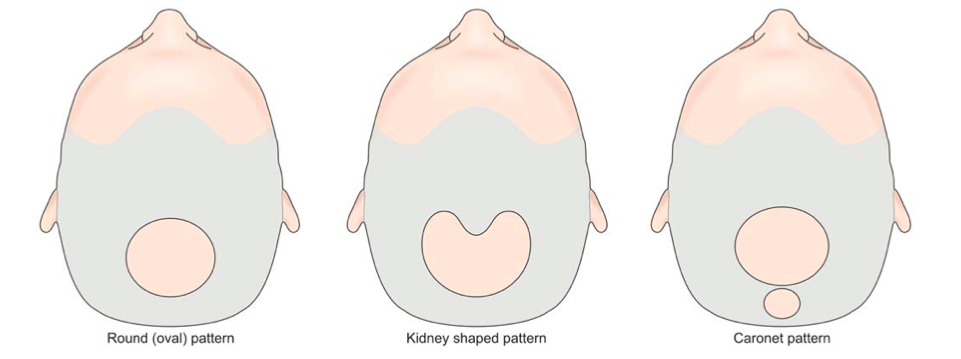Hair Transplant for the Crown Part 2: Types of Hair Loss and Hair Growth in the Crown and The Billboard Effect
For the sake of completeness, it is worth starting our discussion of crown restoration by understanding the types of hair loss that occur in the crown as well as the types of hair growth patterns as well. Finally, we will discuss the principle of the “billboard effect” which is to say why crown transplants may have a lesser result than transplants performed elsewhere on the scalp.
Crown Hair Loss Patterns
The types of hair loss in the crown can be divided into three patterns: a round or oval pattern, a kidney-shaped pattern with the indentation at the top, and a coronet pattern with a smaller circle of loss adjacent and below the principal one. Wetting the hair down and looking very carefully at the crown (especially looking for the coronet pattern that is sometimes hidden below some miniaturized hair) is important when planning and strategizing for a hair-transplant procedure.

Types of Hair Loss Patterns in the Crown
As will be discussed in the upcoming articles in this blog series, the crown typically has a whorl pattern, i.e., a spiral of hair, which must be recreated. If someone is completely bald, then the surgeon has freedom to create the crown how ever he or she sees fit. However, if the patient still has existing hair in the crown, then the surgeon must match the angle and flow of the existing hairs in that region. The most common pattern is a clockwise whorl, or as pictured an “S” pattern. The next most common is the Z pattern, with far smaller percentage of individuals having two whorls SS or a SZ. There is however no ZZ pattern found in nature. The diffusion pattern is much more commonly found in women.

Patterns of Hair Growth in the Crown
The Billboard Effect
The “billboard effect” describes why hairs transplanted into the crown may have per transplanted graft less visual punch than the same number of hairs transplanted into the frontal hair area.

"The Billboard Effect"
First of all, hairs transplanted into the crown region lie on the vertical plane of the scalp. Like a billboard that is a vertical structure, you are looking straight on at the naked scalp. Compare this with the top horizontal plane of the scalp where you are not looking straight on at the bald scalp but from an angle. Therefore, hairs transplanted into the crown still can show visibility of the bald scalp since you are looking straight on at it. Secondly, hairs that are transplanted into the crown in a whorl pattern are going in all different directions meaning that they splay open and thereby can show more bald scalp. For both of these reasons, it is always important to undersell a patient what a transplant in the crown can do. I typically admonish a patient that at times I need two full sessions to accomplish a remarkable result in the crown region, but obviously not always.
Samuel M. Lam, MD, FACS is a board certified hair restoration surgeon in Dallas, Texas. To learn more about Dr Lam’s crown hair transplant procedures please visit our website hairtx.com or call 972-312-8105 to schedule a consultation.




